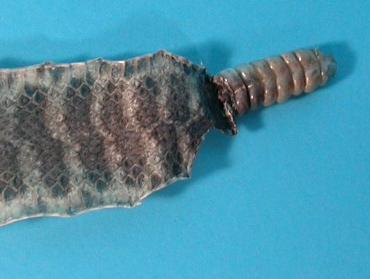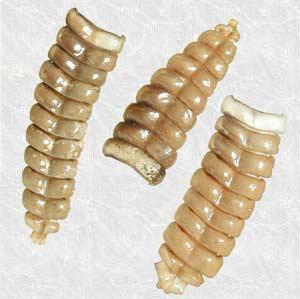RATTLESNAKE
RATTLES
(Rattlesnake:
Fr-serpent
à sonnettes; Ger-Klapperschlange;
Nor-klapperslange; Rus- гремучая змея-?)
A. Rattlesnake
(Crotalus viridis (Rafinesque, 1818))
rattles and
part of its skin (length of rattles ~7
cm) from Montana prairie. (©
photo courtesy Chichester Inc., from www.chichesterinc.com)
DESCRIPTION: Phylum, Chordata;
subphylum, Vertebrata; class, Reptila; order,
Squamata; suborder, Serpentes; family, Viperidae: "Rattlesnake rattles
are derived
entirely from epidermal tissue, just as any other skin cell on
their body. They are [, however,] composed of a higher
concentration of
keratin [my underline]
so they can resist friction against one another during rattling
behaviors ..." (personal communication, Dr. Steve Huskey [Western
Kentucky University], email,16 Dec.
2005).
Colors -
yellowish, tan to dark brown, medium gray to almost black - varies with
species and for some individual species with their environment.
H. ~2½ << an example of
plate-like keratin-rich material.
S.G. ~1.29 << an example of
plate-like keratin-rich material.
Light transmission - tanslucent to
nearly opaque
Luster - dull, horn-like to waxy
Breakage - somewhat brittle
Miscellaneous - Complete "rattles"
have roughly rounded terminal ends --
i.e., the original "button"
remains; incomplete "rattles" have roughly tiered
ends because
one
or
more segments have been broken off (see Figure B).
OTHER
NAMES: Although different
rattlesnakes have different scientific names and several have been
given vernacular designations (e.g., timber
and diamondback rattlers),
nearly all "rattles" marketed as jewelry or curios are merely called
rattlesnake rattles.
USES:
"Rattles"
from snakes are used as parts of necklaces, earrings,
bracelets and brooches/pins; fobs for watches and key
rings; pulls for
light cords; etc. One
of the more interesting uses of rattlesnake rattles is by some country
fiddle-players -- especially those of the southern
Appalachians -- who put rattles in their fiddles: This
custom has been characterized diversely as symbolizing machoism -- "way
back, the fiddle used to
be a woman's instrument and putting the rattles inside 'masculinizes'
it for men folk to play"; making the fiddle
sound better -- "the rattles inside "sang along" with the music giving
it a better & sweeter sound"; [and/or] for
upkeep -- "supposedly,
their odor would keep
rats and mice from nesting in or molesting precious instruments." (all quotations from
Ford, 1998-2005).
A professional musician who read
this entry observed: "I would have to think that the most common of
these reasons would be just for the buzzing sound the rattles would
create."
Whatever the reason(s), it seems
that the custom
has
spread
so now rattlesnake rattles are also stashed in guitars.
B. Rattlesnake
(Crotalus atrox Baird & Girard,
1853 - "western
diamondback")
rattles (lengths
~5 cm),
from desert area of the south-western United States. These
rattles
have "been legally obtained ... according to the New York State
Department of Environmental Conservation and U.S. Fish & Wildlife
Service." The shapes of the ends of these rattles
indicate that the snakes from which they came lost at least the
original button ends and perhaps one or more rattles. (©
photo courtesy The Evolution store, from www.TheEvolutionStore.com)
OCCURRENCES
& NOTEWORTHY LOCALITIES: Rattlesnakes are
Western Hemisphere venomous snakes. For general
distribution information Behler and King (1979) is a good reference. Several publications
outline the occurrence of specific rattlesnakes within given areas (e.g., states).
REMARKS: Considering the fact
that rattlesnakes are native only to the Western Hemisphere, the origin
of
the
name in English dates back only to the 17th century.
Nevertheless,
the
roots of the two words snake
and rattle may be
relevant: Snake is said to have the
following roots "O.E.[Old English] from
P.Gmc.[Proto-Germanic] snaca,*snakon (cf. O.N [Old Norse]. snakr 'snake,'
Swed[ish]. snok,
Ger[man]. Schnake
'ring snake'), from PIE [Proto-Indo-European] base snag-, sneg- 'to crawl, creeping
thing' (cf. O.Ir.[Old Irish] snaighim 'to
creep,' Lith[uanian]. snake 'snail,' O.H.G.[Old
High German] snahhan 'to
creep'). Rattle
may date from "c[irca].1330, perhaps in
O.E.[Old
English], but not recorded; if not, from M.Du.[Middle Dutch] ratelen,
probably of imitative origin (cf.
Ger[man]. rasseln
"to rattle," G[ree]k. kradao
"I rattle").(Harper, 2002).
Rattlesnakes,
which belong to the Crotalus
and Sistrurus genera, have loosely
attached, keratinous tail segments that
produce a "rattling" sound when vibrated. A rattle
segment is added each time the snake sheds its skin. Rattles are
not shed, so the number of rattle segments is indicative of the age of
the snake -- i.e., the older the snake, the more
segments. But, the number of rattles should not be used to
indicate the snake's age in years; snakes
frequently
shed their skin more than once a year, and rattlers have been known to
lose posterior segments. Also, snakes often lose one or more
segments of their rattles -- the appearance of the rattles in Figure B
is typical of those lacking the first (i.e.,
oldest) segment, which is rounded and
called a
button, and perhaps also one or more other early formed segments.
"The
Rattlesnake" -- Having
spent my youth in St. Lawrence County, New York, where Frederic
Remington was born and spent his youth, it would have been blasphemous
for me not to mention this famous
sculpture. Incidentally, the Frederic
Remington
Art Museum is in Ogdensburg, New York just 22 miles from the home of my
youth.
The noise
rattlesnakes make -- to me more a buzzing
than a rattling -- is not, as
some think, from little
bones
lodged in their tails; nothing is in there! Instead, the
"rattling" sound occurs when the snake makes
its tail vibrate and the segments of its tail brush against each other. Some
scientists believe that at least some species of rattlers may
"rattle" to lure birds and other prey. Indeed, some of the
"rattle" sounds do resemble the sounds of insects, so perhaps nearby
birds do go to the noise with the hope of finding food (not a hungry
snake!). Two additional observations recorded about this
"rattling" are
interesting (if true): "The noise they make
... is loudest in fair weather; in rainy
weather they make no noise at all. [And,] It is remarkable,
that
whenever a single snake rattles, all that are within hearing ‘rattle in
like manner." (Wesley..., 1993-2005).
"Don't tread on
me."
SIMULANTS:
Casts
consisting of plastics, resins etc.
that have
been
made by using molds made of natural rattles may or may not be
considered to be simulants -- i.e.,
they may be considered replicas. Whichever, these imitations can be
distinguished from natural rattlesnake rattles by macroscopic
examination.
REPLICAS: Castings of
gold, silver, diverse
alloys, ceramics (including terra cotta), glass, as well as the above
mentioned plastic and resin "rattles" are widely marketed. Also,
note the following
advertisement: "Carved
stone rattlesnake rattles - We have a few
carved stone rattlesnake rattles for sale ... They are available
in Aragonite, Jasper and Hematite. They can be used many different ways
and have a 2mm hole drilled through the top, perfect for hanging on a
necklace, made into key chains or any other idea you may come up with.
Each rattle measures approximately 2 inches in length." (Bliss, 2005) Another rock --
pipestone -- has been carved to replicate rattlesnakes, and the one I
saw had some eye-catching entching around small, round turquoise on its
back. In addition,
replicas of several sizes have been fashioned to resemble
complete or certain parts of rattlesnakes -- e.g., "metallic rattlesnake-motif
belt buckles" (Rubio, 1998, p.185),
fetishes carved from diverse gemstones, and carvings
ranging
from those that are ornately bejeweled to the one shown in Figure
B.
B. Rattlesnake
cane.
Carved top of cane (length shown - 60 cm) with rattlesnake, including
the rattles, motif. (photo by
Dick Dietrich)
R.V.
Dietrich © 2015
Last update: 8
September 2007
web page created by Emmett Mason


